Investigation of Crystallization Growth Characteristics of Mg(OH)2 Crystals under Unconstrained Conditions
Abstract
:1. Introduction
2. Materials and Methods
2.1. Experimental Materials and Equipment
2.2. Experimental Procedure
2.3. Analysis and Detection
3. Experimental Results and Discussion
3.1. The Influence of Reaction Temperature on the Crystalline Growth Habit of Mg(OH)2 Crystals
3.2. The Influence of Hydrothermal Time on the Crystalline Growth Habit of Mg(OH)2 Crystals
3.3. The Influence of MgO Initial Concentration on the Crystalline Growth Habit of Mg(OH)2 Crystals
3.4. Study on Hydrothermal Crystallization Process of Mg(OH)2
4. Conclusions
- Temperature Impact: The growth morphology and crystallinity of Mg(OH)2 are significantly influenced by the hydrothermal temperature. Higher temperatures facilitate the formation of well-defined crystalline structures due to enhanced dissolution and recrystallization processes.
- Reaction time Effect: Extended hydrothermal durations lead to larger, more uniformly sized Mg(OH)2 particles. This suggests that longer reaction times allow for the continuous growth and improvement of crystalline perfection.
- Concentration Influence: The concentration of MgO plays a critical role in the crystallization process of Mg(OH)2. Lower concentrations favor the dissolution process, leading to finer particles, while higher concentrations promote crystallization, resulting in larger crystal sizes. However, excessively high concentrations may lead to supersaturation, hindering the self-perfection of Mg(OH)2 crystals by promoting rapid precipitation without sufficient time for orderly crystal growth.
- Micromorphology Change: SEM images reveal that the particle morphology of Mg(OH)2 changes with varying hydrothermal conditions. The transition from irregular agglomerates to more uniform and discrete particles indicates the influence of hydrothermal parameters on particle shape and aggregation behavior.
- Particle Size Distribution: The particle size distribution shifts toward larger sizes with increased treatment time and temperature, reflecting the growth dynamics of Mg(OH)2 particles. The dissolution and recrystallization mechanism is evident from the changing particle size distributions, with initial stages showing a wide distribution that narrows as crystals grow and mature.
Author Contributions
Funding
Institutional Review Board Statement
Informed Consent Statement
Data Availability Statement
Conflicts of Interest
References
- Shen, H.Y.; Li, Y.Z. Preparation and in-situ modification of nano-sized magnesium hydroxide. Chem. Ind. Eng. Prog. 2017, 36, 294–298. [Google Scholar] [CrossRef]
- Aristotle, T.; Aaron, D.M.; Marla, C. Microalgal biosorption of heavy metals: A comprehensive bibliometric review. J. Hazard. Mater. 2021, 402, 123431. [Google Scholar] [CrossRef] [PubMed]
- Sugita, H.; Morimoto, K.; Saito, T. Simultaneous removal of arsenate and fluoride using magnesium-based adsorbents. Sustainability 2024, 16, 1774. [Google Scholar] [CrossRef]
- Liparoti, S.; Iozzino, V.; Speranza, V. Modulating poly (lactic acid) degradation rate for environmentally sustainable applications. Waste Manag. 2024, 175, 215–224. [Google Scholar] [CrossRef] [PubMed]
- Parinaz, A.; Fatemeh, O.; Maryam, H. Nanotechnology, and scaffold implantation for the effective repair of injured organs: An overview on hard tissue engineering. J. Control. Release 2021, 333, 391–417. [Google Scholar] [CrossRef] [PubMed]
- Suihkonen, R.; Nevalainen, K.; Orell, O. Performance of epoxy filled with nano-and micro-sized magnesium hydroxide. J. Mater. 2012, 47, 1480–1488. [Google Scholar] [CrossRef]
- Hasnat, R.M.; Hassan, K.M.; Saha, S. Flame retardant polymer composite and recent inclusion of magnesium hydroxide filler material: A bibliometric analysis towards further study scope. Fire 2023, 6, 180. [Google Scholar] [CrossRef]
- Kiliaris, P.; Papaspyrides, C.D. Polymer/layered silicate (clay) nanocomposites: An overview of flame retardancy. Prog. Polym. Sci. 2010, 35, 902–958. [Google Scholar] [CrossRef]
- Song, Y.Y. Study on preparation and flame retardancy of polypropylene/magnesium hydroxide composites. New Chem. Mat. 2023, 51, 574–576. [Google Scholar] [CrossRef]
- Zhang, H.Y.; Wang, H.Q.; Wang, H.Q. Flame retardant mechanism and surface modification of magnesium hydroxide flame retardant. IOP Conf. Ser. Earth Environ. Sci. 2018, 170, 032028. [Google Scholar] [CrossRef]
- Pilarska, A.A.; Klapiszewski, Ł.; Jesionowski, T. Recent development in the synthesis, modification and application of Mg(OH)2 and MgO: A review. Powder Technol. 2017, 319, 373–407. [Google Scholar] [CrossRef]
- Piperopoulos, E.; Scionti, G.; Atria, M. Flame-Retardant Performance Evaluation of Functional Coatings Filled with Mg(OH)2 and Al(OH)3. Polymers 2022, 14, 372. [Google Scholar] [CrossRef] [PubMed]
- Soni, P.; Sinha, S. Fiber and future: Unleashing the power of industrial hemp waste through epoxy composites. Polym. Compos. 2024, 45, 413–423. [Google Scholar] [CrossRef]
- Cheng, X.W.; Xuan, K.; Guan, J.P. Construction of silane-modified nanoscale magnesium hydroxide as an inorganic flame-retardant coating for silk textiles. Colloids Surf. A Physicochem. Eng. Asp. 2023, 676, 132287. [Google Scholar] [CrossRef]
- Gulsah, O.; Orkun, E.; Suleyman, G. Flame-retardant features of various boron compounds in thermoplastic polyurethane and performance comparison with aluminum trihydroxide and magnesium hydroxide. Fire Mater. 2022, 46, 1020–1033. [Google Scholar] [CrossRef]
- Scionti, G.; Piperopoulos, E.; Atria, M. Effect of magnesium hydroxide and aluminum hydroxide as thermal barriers on the flame-retardant behavior of acrylic-based coating. Coatings 2023, 13, 1517. [Google Scholar] [CrossRef]
- Miće, J.; Jelena, J.; Branka, A. Thermal degradation of polyethylene oxide—Effect of magnesium hydroxide addition. J. Therm. Anal. Calorim. 2022, 148, 1589–1598. [Google Scholar] [CrossRef]
- Granda-Ruiz, J.V.; Cajas-Salazar, N.; Rodriguez-Paez, J.E. Magnesium oxyhydroxide nanoparticles: Synthesis, characterization and evaluation of their genotoxicity in Vicia faba L. Mater. Sci. Eng. B 2023, 298, 116896. [Google Scholar] [CrossRef]
- Sreenivasan, H.; Bernard, E.; Santos, S.H. A critical review of magnesium silicate hydrate (M-S-H) phases for binder applications. Cem. Concr. 2024, 178, 107462. [Google Scholar] [CrossRef]
- Jiang, W.J.; Hua, X.; Han, Q.F. Preparation of lamellar magnesium hydroxide nanoparticles via precipitation method. Powder Technol. 2009, 191, 227–230. [Google Scholar] [CrossRef]
- Liu, Z.Q.; Li, L.J.; Zeng, Z.M. Monodisperse hexagonal sheet magnesium hydroxide was prepared from chloromagnesite. Mater. Sci. Technol. 2011, 19, 138–144. [Google Scholar]
- Huang, J.C.; Ling, G.S.; Zong, J. Study on New Technological Conditions for Preparing Highly Dispersed Hexagonal Sheet Nano-Sized Magnesium Hydroxide from Magnesite. Inorg. Chem. Ind. 2021, 53, 55–60. Available online: https://kns.cnki.net/kcms/detail/12.1069.TQ.20200716.1433.004.html (accessed on 27 March 2024).
- Wang, Q. Preparation of Magnesium Oxide with Diffe rent Properties Based on Magnesite and Its Influence on Hydration Product Magnesium Hydroxide. Master’s Thesis, North China University of Science and Technology, Tangshan, China, 2022. [Google Scholar] [CrossRef]
- Liu, M.X.; Li, J.; Zhang, L. Study on preparation of flame retardant hexagonal flake magnesium hydroxide from brine. J. Salt Sci. Chem. Ind. 2022, 51, 16–20. [Google Scholar] [CrossRef]
- Zhao, Z.Y.; Li, X.G.; Wang, S.R. Study on the preferential growth conditions of hexagonal sheet magnesium hydroxide (001) crystal face. J. Synth. Cryst. 2014, 43, 1611–1619. [Google Scholar] [CrossRef]
- Ling, G.S.; Zong, J. Study on the process affecting the preparation of nano-sized magnesium hydroxide from microcrystalline magnesite. J. Salt Sci. Chem. Ind. 2021, 50, 11–16+20. [Google Scholar] [CrossRef]
- Wu, Y.M.; Sun, Y.Z.; Lu, G.M. Preparation of hexagonal sheet magnesium hydroxide by crystallization and hydrothermal method. J. Chem. Eng. Chin. Univ. 2019, 33, 425–434. [Google Scholar] [CrossRef]
- Henrist, C.; Mathieu, J.P.; Vogels, C. Morphological study of magnesium hydroxide nanoparticles precipitated in dilute aqueous solution. J. Cryst. Growth 2003, 249, 321–330. [Google Scholar] [CrossRef]
- Kumari, L.; Li, W.Z.; Vannoy, C.H. Synthesis, characterization and optical properties of Mg (OH)2 micro-/nanostructure and its conversion to MgO. Ceram. Int. 2009, 35, 3355–3364. [Google Scholar] [CrossRef]
- Ding, Y.; Zhang, G.; Wu, H. Nanoscale magnesium hydroxide and magnesium oxide powders: Control over size, shape, and structure via hydrothermal synthesis. Chem. Mater. 2001, 13, 435–440. [Google Scholar] [CrossRef]
- HG/T 3821-2006; Nano-Powder of Magnesium Hydroxide. Chemical Industry Press: Beijing, China, 2006.
- Fan, T.B.; Jiang, Y.; Liu, L.P. Synthesis of hexagonal flake magnesium hydroxide by one step hydrothermal method and its growth habit analysis. J. Synth. Cryst. 2017, 46, 2319–2325. [Google Scholar] [CrossRef]
- Sichov, M.; Boriak, K.; Kolomiets, L. Technology for obtaining high-pure magnesium compounds using the hydrolytic processes of sedimentation. East.-Eur. J. Enterp. Technol. 2022, 1, 43–52. [Google Scholar] [CrossRef]
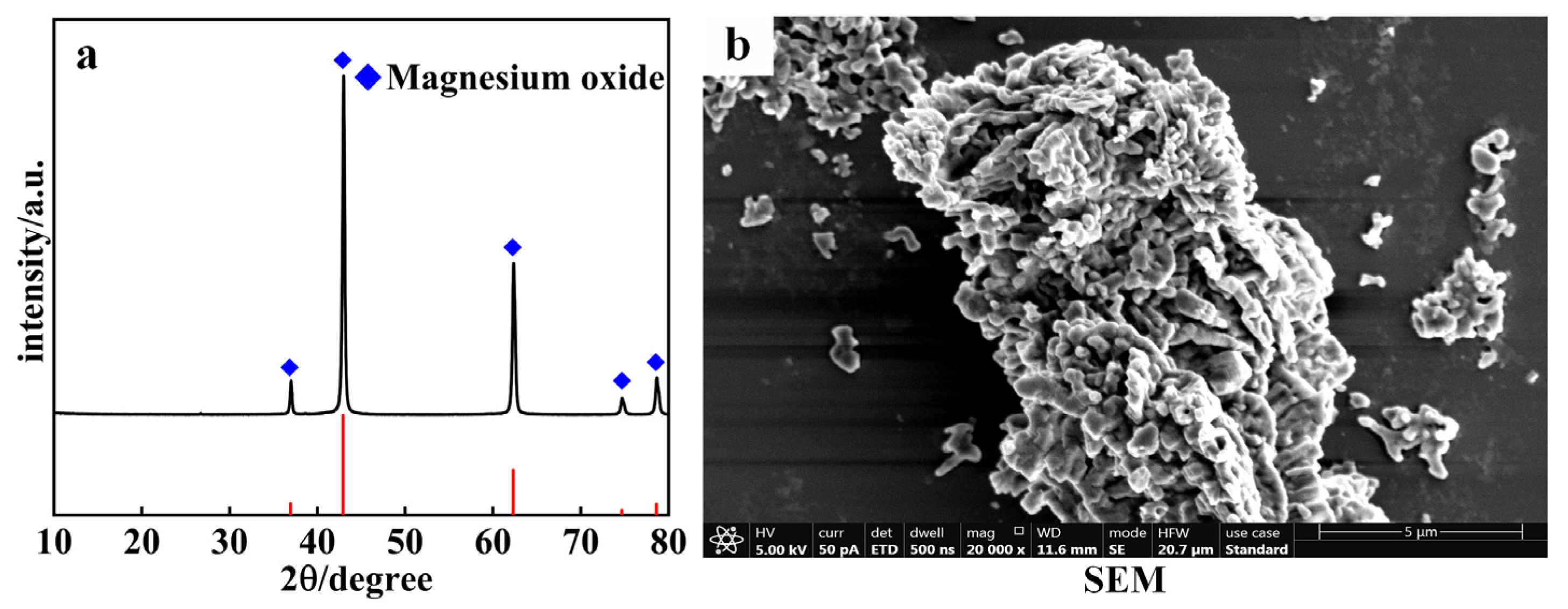
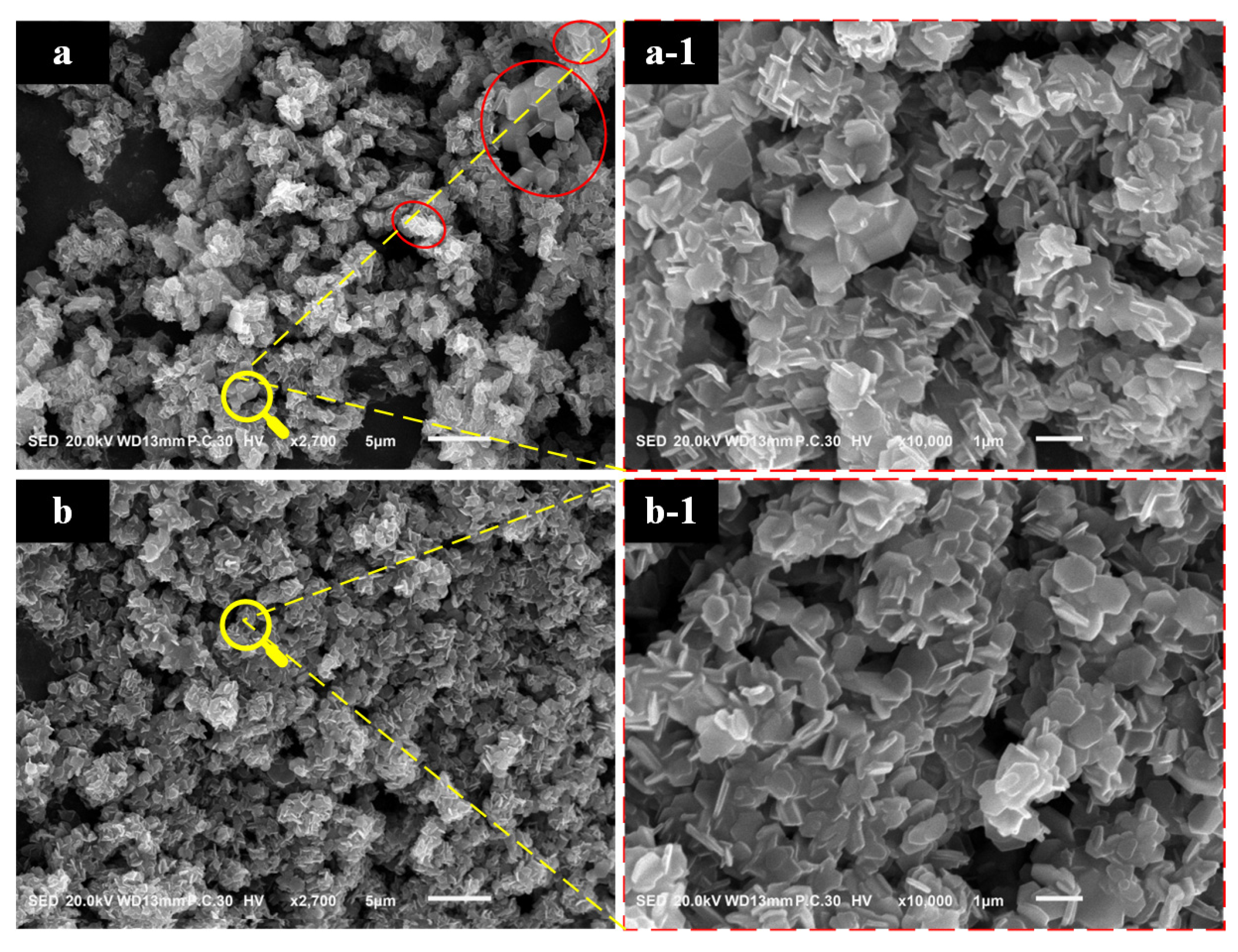
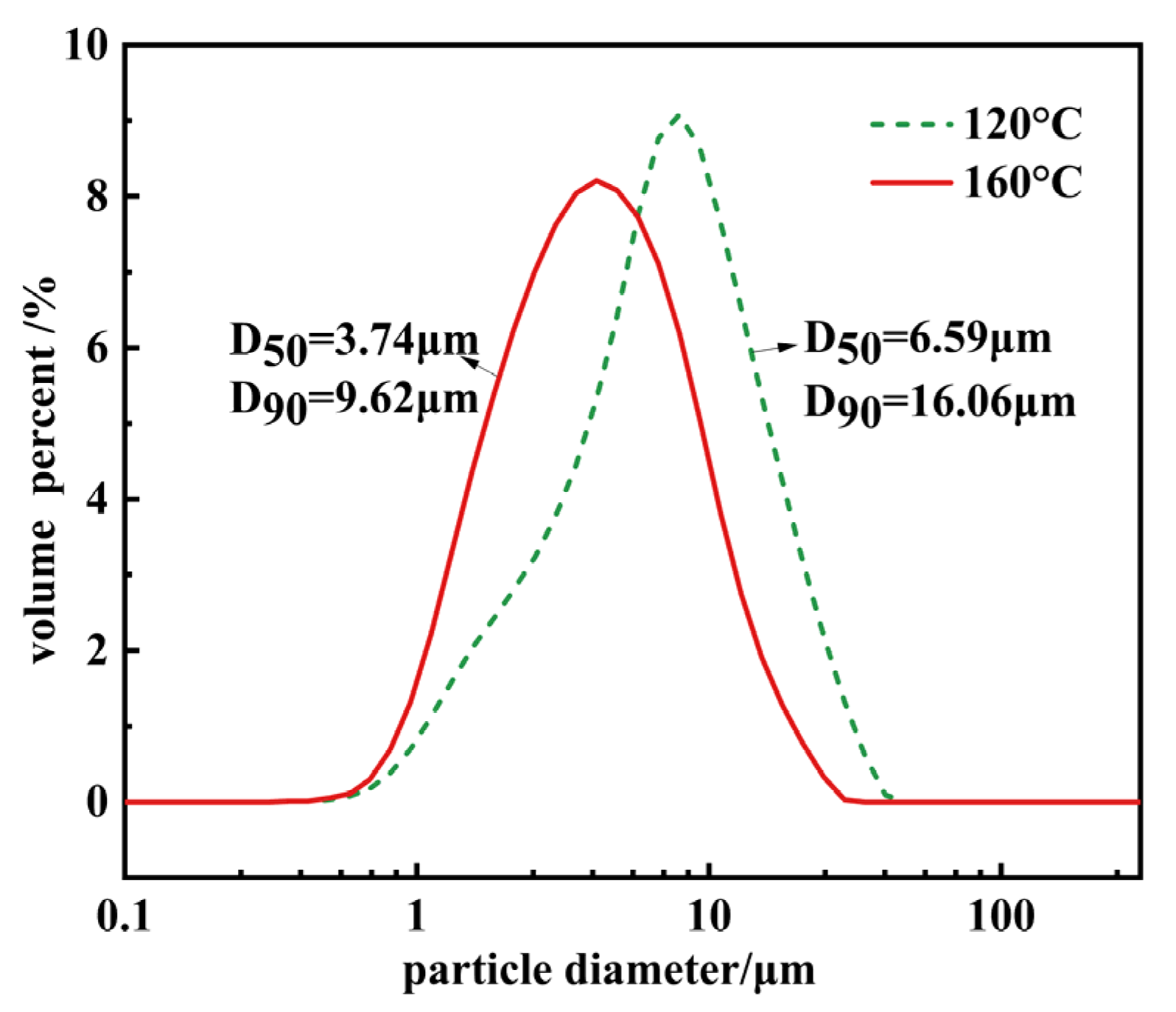
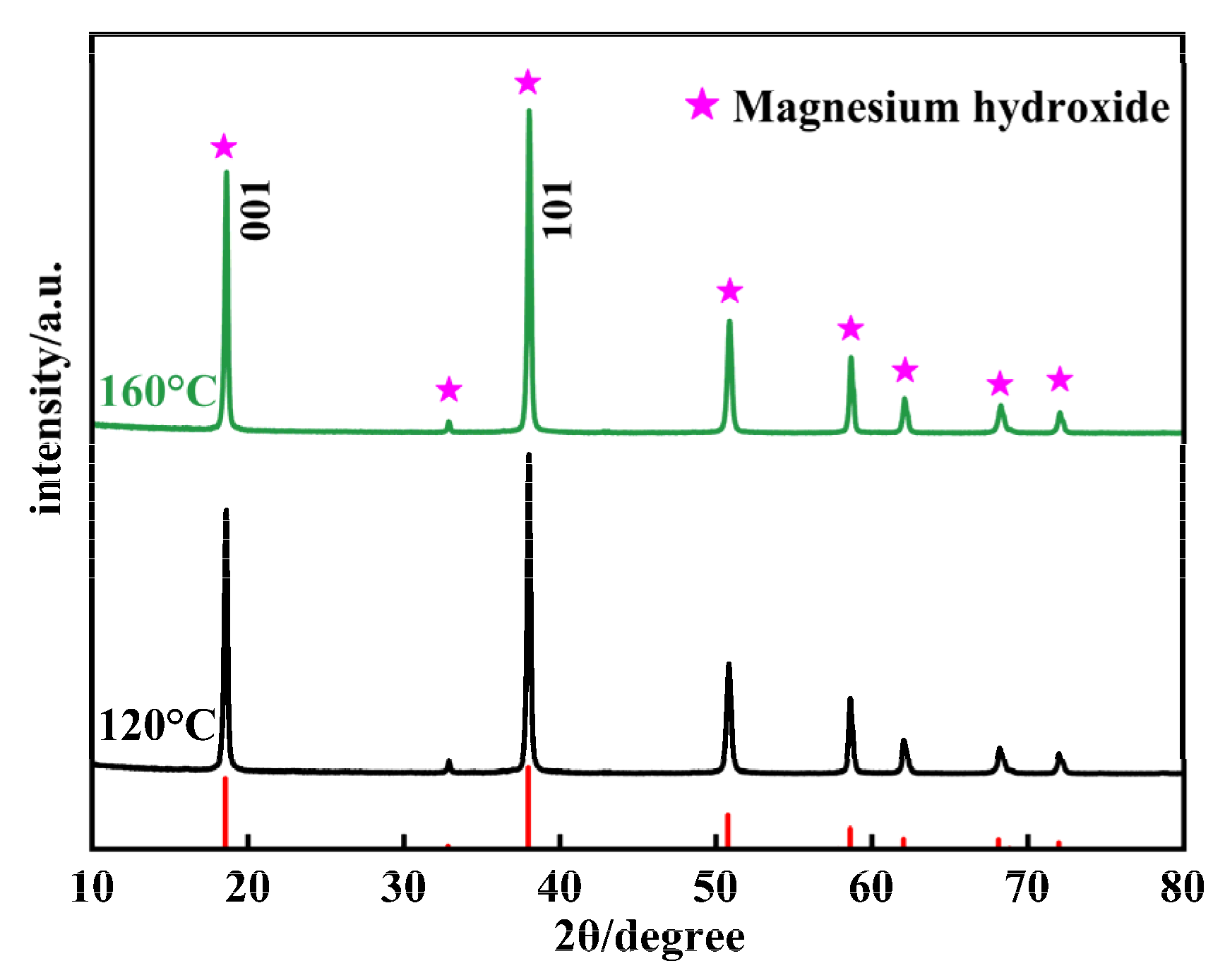
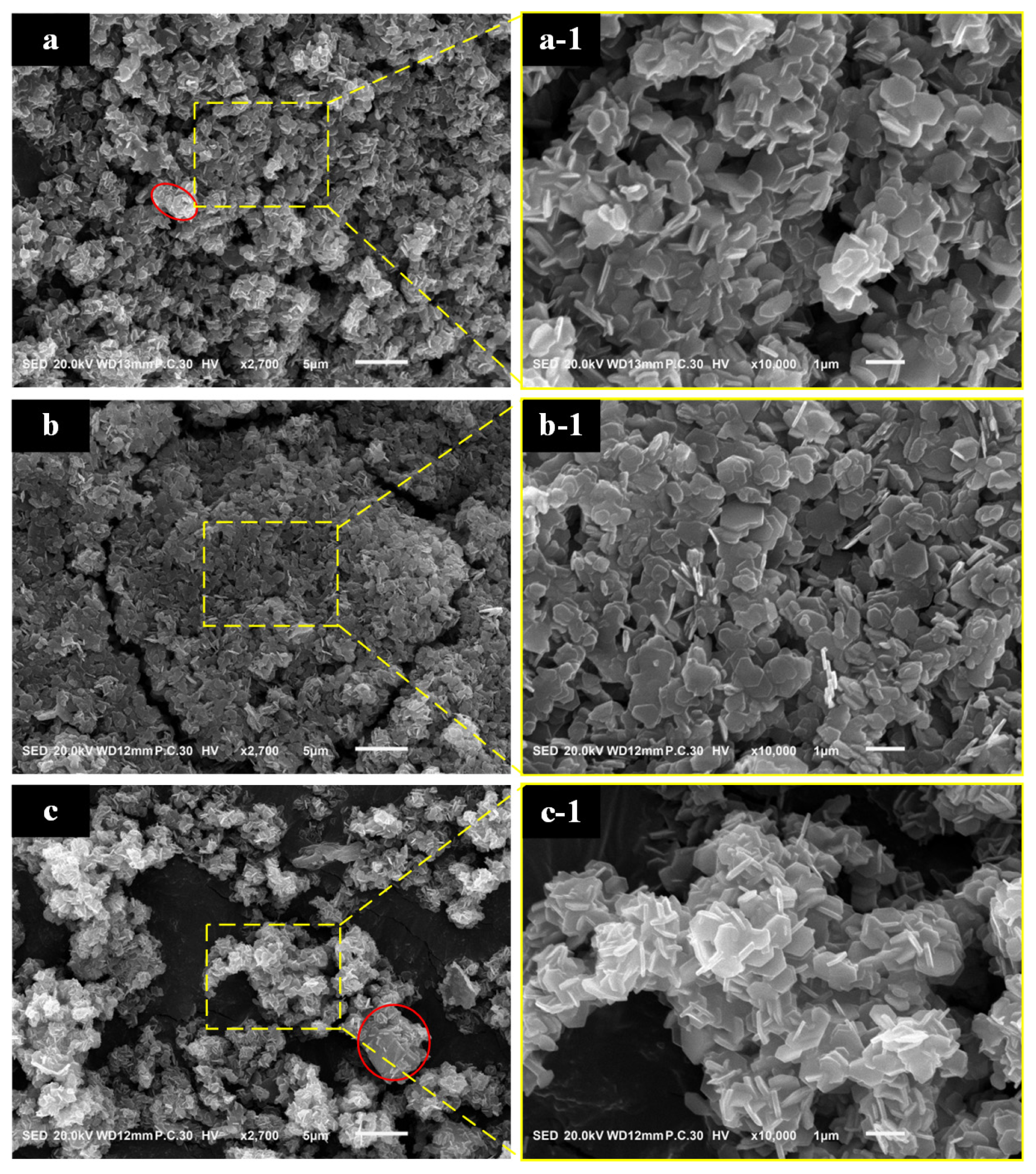
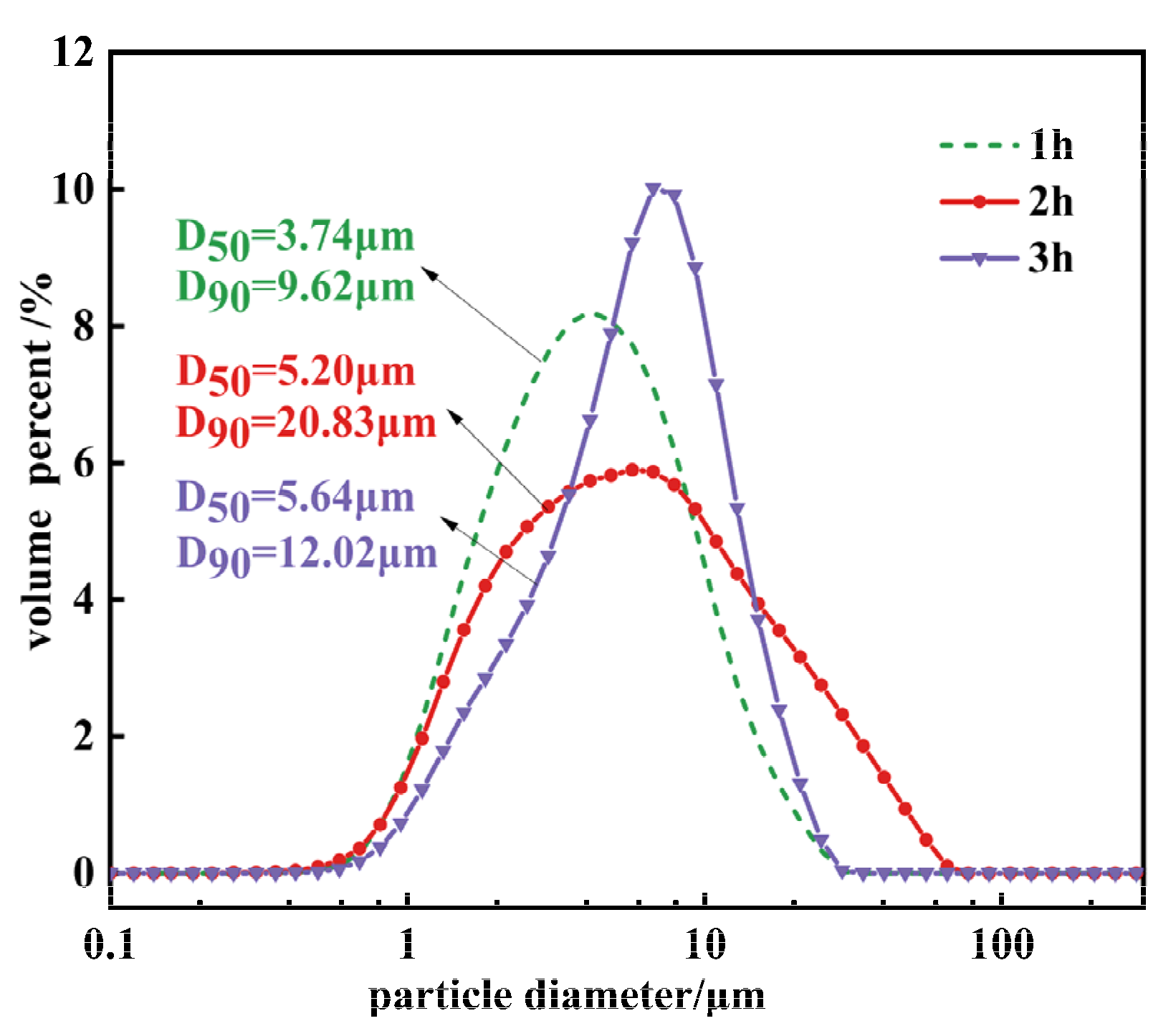


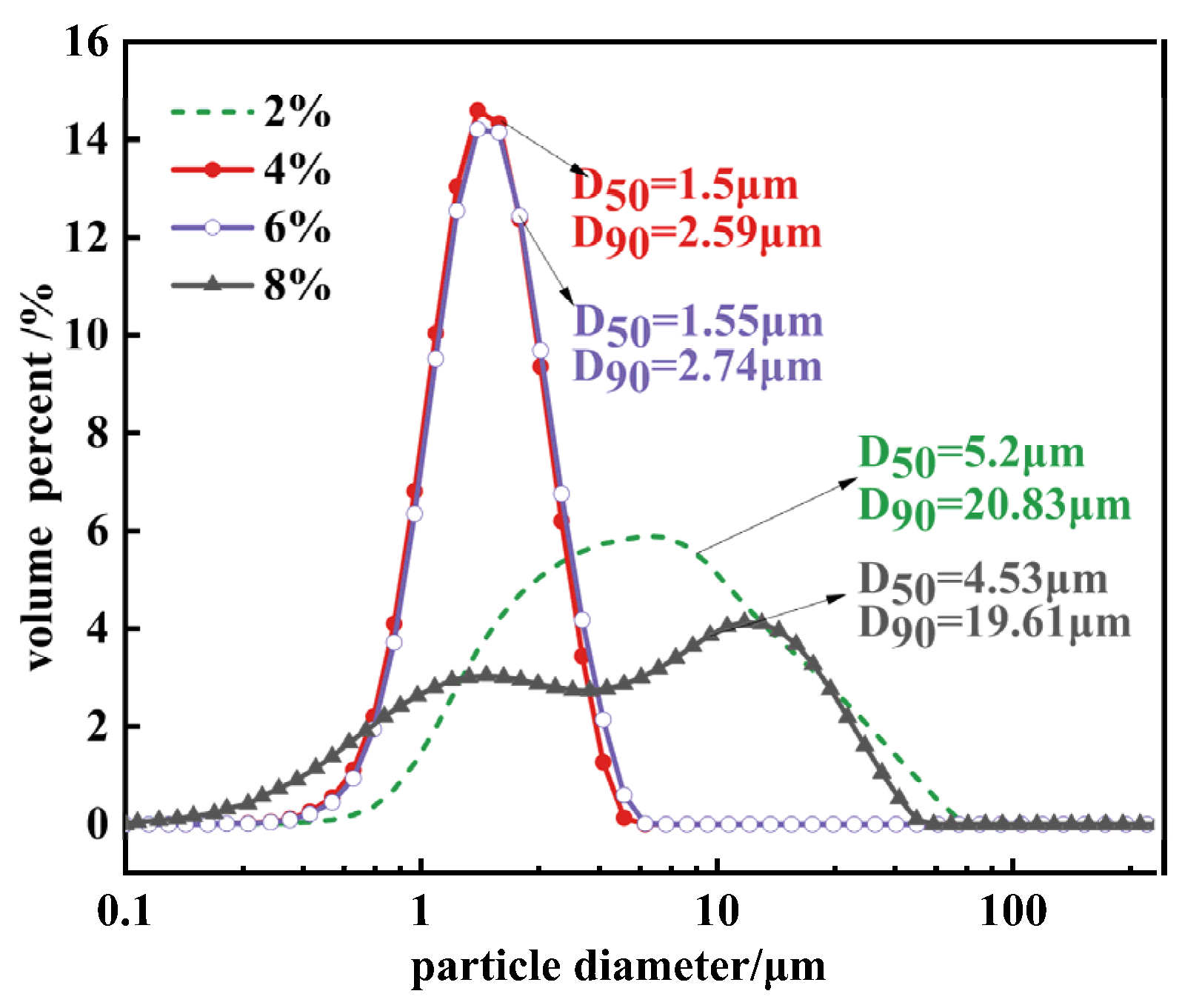
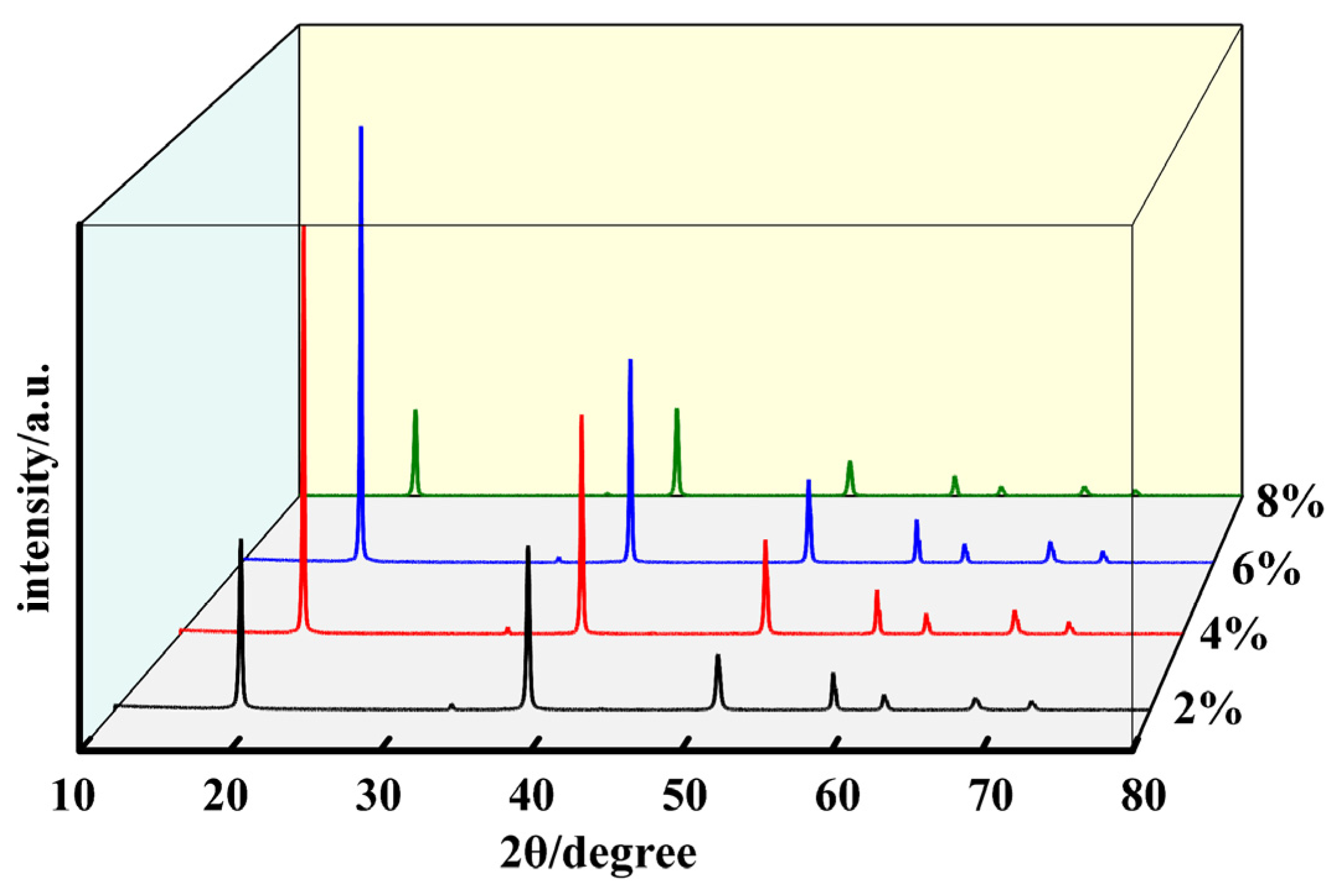
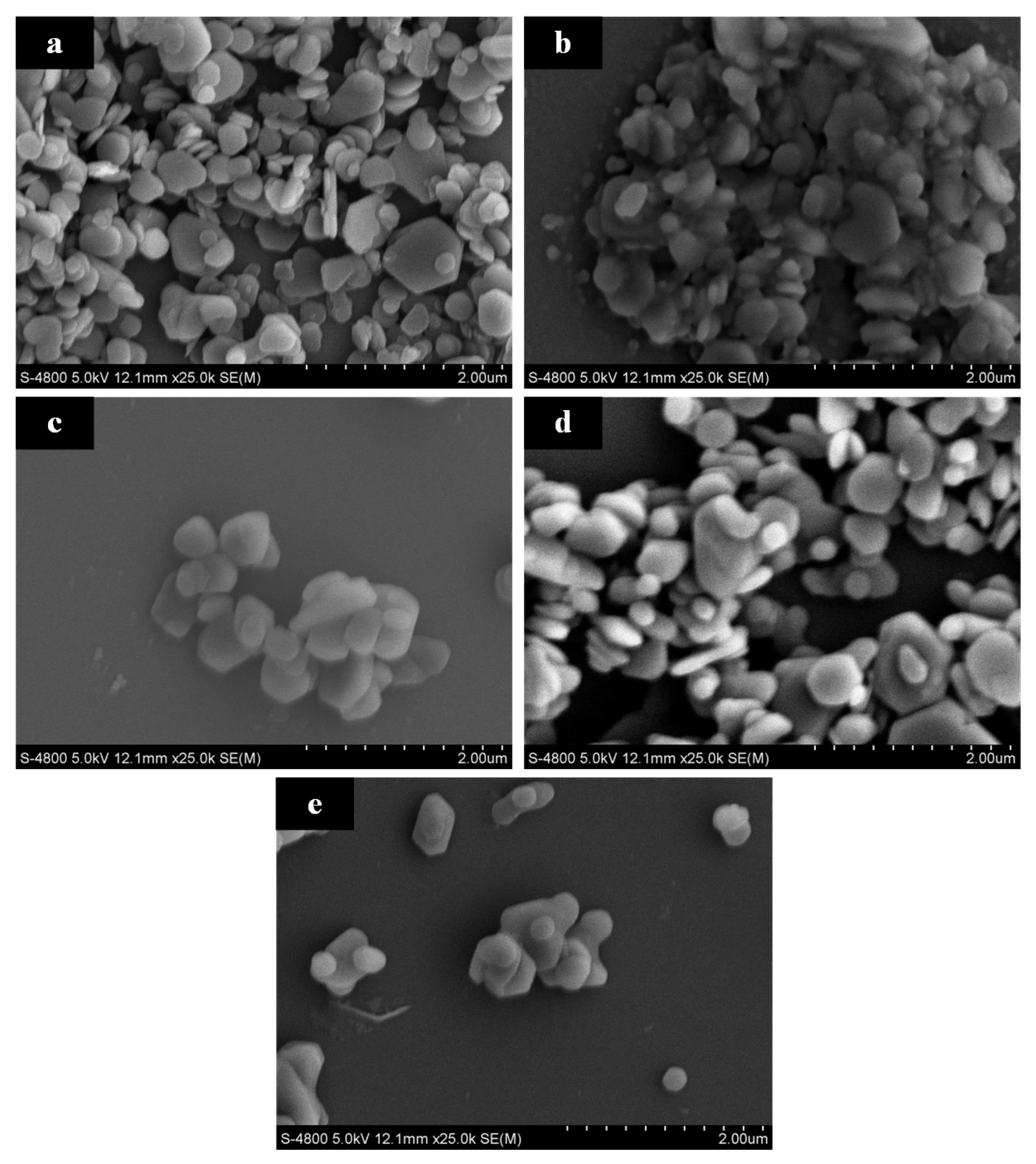
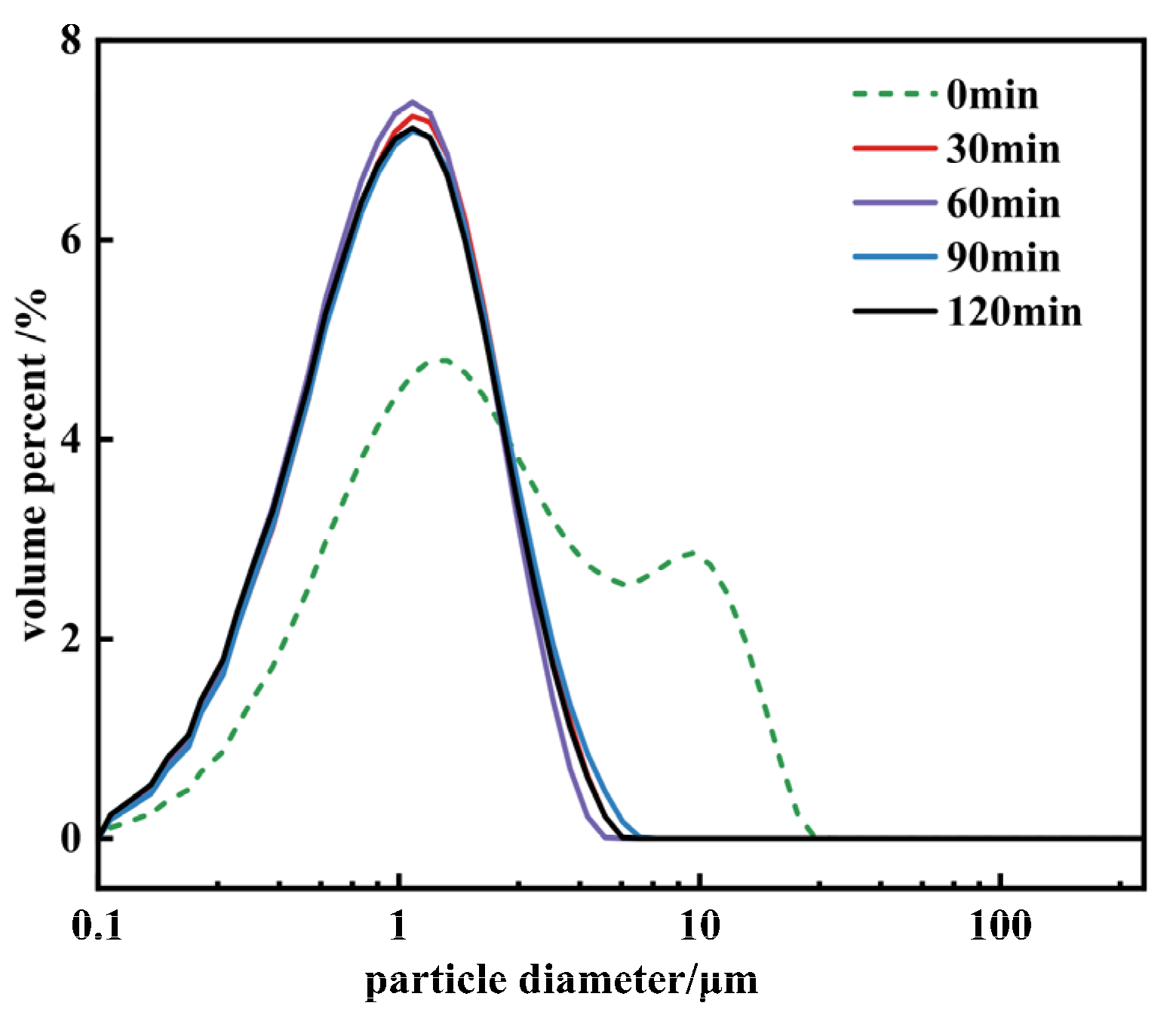

| I001 Crystallographic Plane | I101 Crystallographic Plane | ||||||||
|---|---|---|---|---|---|---|---|---|---|
| 2θ /Degree | Intensity /a.u. | FWHM /Å | 2θ /Degree | Intensity /a.u. | FWHM /Å | D50 /μm | D90 /μm | I001/I101 | |
| 0 min | 18.57 | 77,997 | 0.218 | 37.97 | 58,735 | 0.222 | 1.69 | 9.31 | 1.33 |
| 30 min | 18.57 | 76,013 | 0.189 | 37.97 | 68,577 | 0.206 | 0.92 | 2.17 | 1.11 |
| 60 min | 18.57 | 118,004 | 0.178 | 37.97 | 65,285 | 0.199 | 0.88 | 2.01 | 1.81 |
| 90 min | 18.57 | 103,544 | 0.177 | 37.97 | 67,176 | 0.203 | 0.93 | 2.25 | 1.54 |
| 120 min | 18.57 | 125,377 | 0.177 | 37.97 | 67,758 | 0.196 | 0.90 | 2.14 | 1.85 |
| Particle Size Range/μm | Particle Proportion | ||||
|---|---|---|---|---|---|
| 0 min | 30 min | 60 min | 90 min | 120 min | |
| 0~0.2 | 8.17% | 23.26% | 0.00% | 1.24% | 0.00% |
| 0.2~0.4 | 62.75% | 48.84% | 38.89% | 49.23% | 33.33% |
| 0.4~0.6 | 25.17% | 16.28% | 41.67% | 38.39% | 41.67% |
| 0.6~0.8 | 3.92% | 9.30% | 11.11% | 8.98% | 11.67% |
| 0.8~1 | 0.00% | 2.33% | 8.33% | 1.24% | 10.00% |
| 1~1.2 | 0.00% | 0.00% | 0.00% | 0.62% | 1.67% |
| 1.2~1.4 | 0.00% | 0.00% | 0.00% | 0.31% | 1.67% |
Disclaimer/Publisher’s Note: The statements, opinions and data contained in all publications are solely those of the individual author(s) and contributor(s) and not of MDPI and/or the editor(s). MDPI and/or the editor(s) disclaim responsibility for any injury to people or property resulting from any ideas, methods, instructions or products referred to in the content. |
© 2024 by the authors. Licensee MDPI, Basel, Switzerland. This article is an open access article distributed under the terms and conditions of the Creative Commons Attribution (CC BY) license (https://creativecommons.org/licenses/by/4.0/).
Share and Cite
Lv, Y.; Bai, L.; Ma, Y.; Zhao, L. Investigation of Crystallization Growth Characteristics of Mg(OH)2 Crystals under Unconstrained Conditions. Materials 2024, 17, 1956. https://doi.org/10.3390/ma17091956
Lv Y, Bai L, Ma Y, Zhao L. Investigation of Crystallization Growth Characteristics of Mg(OH)2 Crystals under Unconstrained Conditions. Materials. 2024; 17(9):1956. https://doi.org/10.3390/ma17091956
Chicago/Turabian StyleLv, Yunqing, Limei Bai, Yuxin Ma, and Liucheng Zhao. 2024. "Investigation of Crystallization Growth Characteristics of Mg(OH)2 Crystals under Unconstrained Conditions" Materials 17, no. 9: 1956. https://doi.org/10.3390/ma17091956
APA StyleLv, Y., Bai, L., Ma, Y., & Zhao, L. (2024). Investigation of Crystallization Growth Characteristics of Mg(OH)2 Crystals under Unconstrained Conditions. Materials, 17(9), 1956. https://doi.org/10.3390/ma17091956






